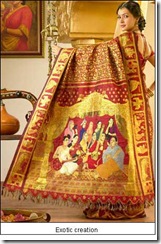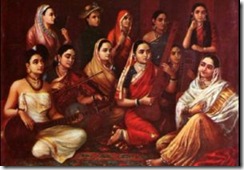 How often have you come across a INR 4 Million ($100,000) silk saree? ( Saree is one of the beautiful garment worn by Indian women . It is draped around the body in many ways and looks really stunning ) Chennai Silks, a textile unit has come up with one of its kind and it is seeking an unmistakable entry into the Guinness Book of World Records for being the most unique and expensive saree.
How often have you come across a INR 4 Million ($100,000) silk saree? ( Saree is one of the beautiful garment worn by Indian women . It is draped around the body in many ways and looks really stunning ) Chennai Silks, a textile unit has come up with one of its kind and it is seeking an unmistakable entry into the Guinness Book of World Records for being the most unique and expensive saree.
The exceptionally stunning saree is meticulously woven with 12 precious stones and metals to depict 11 of Raja Ravi Verma's popular paintings. Explicitly projected is 'Lady Musicians', one of the painter's very famous works that displays women belonging to diverse cultural backgrounds.
Besides, the border of the saree pictures 10 other paintings of the artist that pays tribute to 20th century artist. The best part of the saree being that the women in the paintings are intricately hand-woven and beautified with jewels of gold, diamond, platinum, silver, ruby, emerald, yellow sapphire, sapphire, cat's eye, topaz, pearl and corals.
Already in the Limca Book of Records, this saree will be the first silk saree that required the use of 7,440 jacquard hooks and 66,794 cards during the weaving process. Moreover, a group of consummate workers took nearly 4,680 hours to make this.
Styles of draping ( Courtesy Wiki pedia article on Saree)
 The most common style is for the sari to be wrapped around the waist, with the loose end of the drape worn over the shoulder, baring the stomach. However, the sari can be draped in several different styles, though some styles do require a sari of a particular length or form. The French cultural anthropologist and sari researcher, Chantal Boulanger, categorizes sari drapes in the following families.
The most common style is for the sari to be wrapped around the waist, with the loose end of the drape worn over the shoulder, baring the stomach. However, the sari can be draped in several different styles, though some styles do require a sari of a particular length or form. The French cultural anthropologist and sari researcher, Chantal Boulanger, categorizes sari drapes in the following families.
- Nivi – styles originally worn in Tamil Nadu; besides the modern nivi, there is also the kaccha nivi, where the pleats are passed through the legs and tucked into the waist at the back. This allows free movement while covering the legs.
- North Indian/Gujarati – this style differs from the nivi only in the manner that the loose end is handled: in this style, the loose end is draped over the right shoulder rather than the left, and is also draped back-to-front rather than the other way around.
- Maharashtrian/Kache – This drape (front and back) is very similar to that of the male Maharashtrian dhoti. The center of the sari (held lengthwise) is placed at the center back, the ends are brought forward and tied securely, then the two ends are wrapped around the legs. When worn as a sari, an extra-long cloth is used and the ends are then passed up over the shoulders and the upper body. They are primarily worn by Brahmin women of Maharashtra, Karnataka, Andhra Pradesh and Tamil Nadu.
- Dravidian – sari drapes worn in Tamil Nadu; many feature a pinkosu, or pleated rosette, at the waist.
- Madisaara style – This drape is typical of Brahmin ladies from Tamil Nadu and Kerala
- Kodagu style – This drape is confined to ladies hailing from the Kodagu district of Karnataka. In this style, the pleats are created in the rear, instead of the front. The loose end of the sari is draped back-to-front over the right shoulder, and is pinned to the rest of the sari.
- Gond – sari styles found in many parts of Central India. The cloth is first draped over the left shoulder, then arranged to cover the body.
- the two-piece sari, or mundum neryathum, worn in Kerala. Usually made of unbleached cotton and decorated with gold or colored stripes and/or borders.
- tribal styles – often secured by tying them firmly across the chest, covering the breasts.
1 comment:
In a related note, click here forbrahmin only matrimony for brides and grooms
Post a Comment